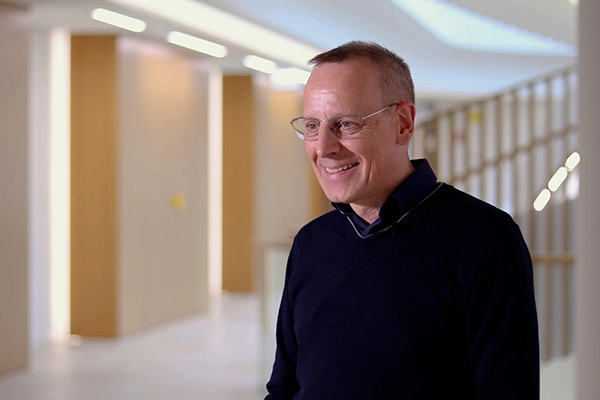Interview with Martin Danz and Matthias Hörteis about Open Innovation at Heraeus
Innovations bring progress - but also challenges. In the Heraeus Innovation Experts series, Heraeus talks to innovation experts about current trends and their impact on companies. Today's topic: the use of open innovation.
By collaborating with external partners such as research institutions, customers, and especially start-ups, innovations often become market-ready more quickly. Open Innovation thus enables the speed that matters today.
The Global Business Unit Heraeus Precious Metals has been successfully using this approach for its new developments for some time now. The two experts Martin Danz, Global Head of Antimicrobial Technologies, and Matthias Hörteis, Technology Scouting Manager, have already had a wide variety of experiences. In this interview, they explain their approach and how important it is to develop a common vision at an early stage when cooperating with external parties.
Read the interview: Transcript of the interview with Martin Danz and Matthias Hörteis
Hello Martin, Hello Matthias, thank you very much for taking the time today to talk to us about innovations.
Both: glad to talk.
Everyone is talking about open innovation. What do you mean by open innovation and why is it important?
Matthias: I would say that innovation, in general, is necessary for a technology company like Heraeus. Open innovation is an important part of that. Why is open innovation important? Because it is simply easier to work with technologies that others have already invented than to have to invent them yourself. Currently, technologies emerge much faster – so it is important to get to market quickly. And if companies get to the market quickly, they have a decisive advantage. The second to market is already the first loser again – that’s where Open innovation can help. The other thing is when you have access to a network, to experts, it gives you a corresponding competitive advantage. And here, too, open innovation is helpful.
Martin: Maybe picking up on what Matthias said and to transfer it to Heraeus. I would say it has two meanings, at least from my point of view. On the one hand, it is the opening of the Heraeus innovation process, which means that our developments are driven forward with external support. This can mean, for example, that we involve customers at an early stage or that we outsource certain development activities to institutes, universities, or other companies. And the other aspect, which Matthias had now also outlined, is the introduction of external ideas, external developments, as happens, for example, through collaboration with start-ups.
What are you specifically doing at Heraeus Precious Metals to build the innovation ecosystem?
Martin: So, in addition to engaging potential customers for our innovation at an early stage, we have built up various activities in the last years. For example, we have set up a start-up program with which we target start-up personalities with attractive ideas and then simply invite them to implement these ideas with Heraeus. In addition, of course, we actively engage in technology scouting. This means that we systematically search the university landscape for new technologies that suit us. Additionally, the whole thing is accompanied by classic start-up scouting. This means that we are specifically looking for start-ups that fit the strategy of Heraeus Precious Metals. In this context, I would like to mention again that we regularly invite start-ups on specific topics to consider together whether there are possible topics for collaboration.
Matthias: Beyond that, what is done at Heraeus Precious Metals is: We have set up good structures for open innovation. It starts with the established scouting and goes all the way to evaluating ideas, which is classic business development. In addition, what is special at Heraeus Precious Metals is the fact that we have platforms. This is something similar to corporate start-ups. They are provided with resources so that they can, in principle, prove that the technology can and should be brought to market. There are currently two of these at Heraeus Precious Metals. One is Hydrogen Systems. This involves the development of catalysts for the hydrogen economy. The other is Heraeus Antimicrobial Technologies. This is a good example of cooperation with a start-up, because the technology comes from a start-up, i.e., from outside. This is now to be brought to commercial success through cooperation.
Matthias, what would you say, does culture play an important role in this process?
Matthias: Yes, corporate culture or open innovation culture. At the end of the day, it's the employees who must have the openness to reach out to other partners. As long as employees say, "Only what I invented myself is the real thing," I think you have a hard time with open innovation. And the right mindset, of course, can be supported by corporate culture.
I think Heraeus is on the right track in supporting this. One example: Heraeus awards an innovation award every year This recognizes outstanding achievements in the field of innovation. And last year, the product AGXX, which is based on cooperation with a start-up, won the prize. This is exactly what we are currently commercializing in antimicrobial technologies. In other words, Heraeus recognizes a collaboration or cooperation similar to internal development.
Matthias, you have already mentioned the cooperation with a start-up for AGXX. Martin, what is the history of Heraeus Precious Metals' cooperation with start-ups?
Martin: Heraeus Precious Metals recognized at an early stage that the opposite of open innovation, closed innovation, simply diminishes innovative strength and thus ultimately limits growth opportunities. In other words, we started very early on to actively engage with start-ups. Since then, we have spoken with over 70 different start-ups and had selected in-depth discussions – and in some cases, these discussions have resulted in specific collaborations. Matthias had just mentioned one of these examples: The collaboration with Largentec on AGXX technology.
What are the challenges for corporates like Heraeus in working with start-ups?
Martin: Yes, there are a few. And if I may summarize, I would like to highlight three. First – and in my opinion, this is also the biggest challenge – the possibly different expectations. It is essential to clarify these at an early stage. What do both partners expect from each other and what do both partners expect from the collaboration? Secondly, I would see Even if the expectations are clarified, it is sometimes very difficult to find a model of cooperation that creates a classic win-win. Because only if both parties enjoy working together, it will become a successful collaboration. And a third challenge is also more substantive. It is important, especially for products and technologies that are still in development, to validate them on the market at an early stage. In other words, the assumed benefits the technology brings should be tested with customers early on.
Matthias: To add to Martin’s points – what the past has shown, is that different values that exist at start-ups and corporates can be a challenge. The motivation to work with a start-up for a corporate is usually characterized by the fact that companies want to realize financial interests. With a start-up, it's often different - especially since the founder is often also the CEO. There might be a small team around the founder, and they are simply convinced of their idea and of a vision of how they want to get there or what they want to change or improve with their technology. The financial interests often take a back seat. Sure, start-ups also want to make money, no question. But that usually isn’t their first priority – especially once the funding has been sorted out. And then, when you want to work together, the challenge is often how to reconcile these interests. If corporates understand that and come to an agreement, they’ll find a good way of working together.
Martin: The statement that something is “purely business, not personal” doesn't exist when interacting with start-ups.
How do you solve these challenges and what are success factors in the collaboration?
Martin: Based on experience, also negative ones, it is really important to develop a common vision very early on. The term vision is a little bit unspecific. To make it specific: We invite the start-up and talk and both sides put in writing what is important to them. And that concerns everything that is important – it doesn't necessarily have to be financial, or technology related. By bringing both sides together and discussing both interests, we produce a “key points paper”, which then sets the framework for further discussions and for the joint development of a term sheet or a joint development agreement. Apart from that, the second point I would like to emphasize is that we do follow the classic fail-fast approach. Together with the start-up, we carry out a feasibility consideration, both in technical terms, but also in economic terms. And this is where it comes into play again that we interact with potential customers at an early stage.
Matthias: This can work quite well as shown by the example with AGXX, the antimicrobial technology. When we started working together with Largentec at an early stage, we agreed quickly that it makes sense for Heraeus to work with Largentec. We also wrote down all the interests – for example what the advantages of a cooperation could be. At the end of the day, the negotiations for a cooperation – either in the form of a strategic cooperation, a licensing agreement, an acquisition or toll manufacturing – took almost half a year. Both sides were often at the point of saying: "Come on, let's break off the whole thing here.” What helped was this shared, written vision. It made people remember: "Come on, we've written something down here. It makes sense. So, let's take this hurdle and then we'll just keep going.” And that was successful in the end.
Thank you both very much for the interview.
Both: Thank you!

